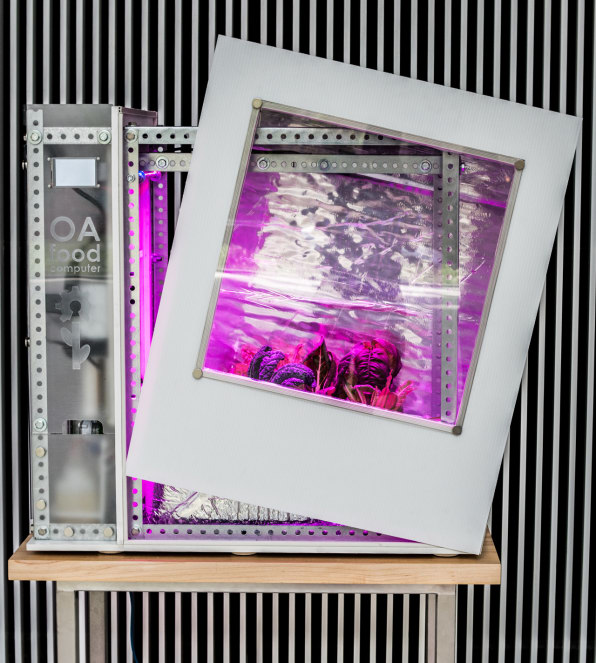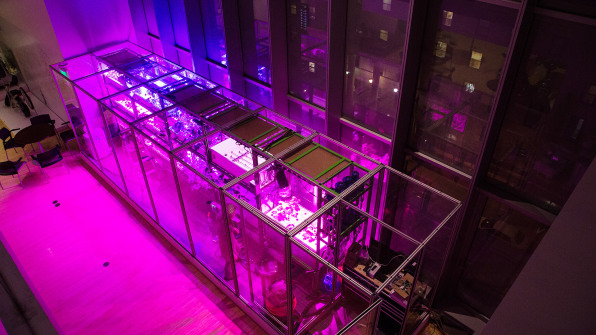These Food Computers Use AI To Make Climate Recipes For The Best-Tasting Crops
Inside a shipping container-sized box at MIT Media Lab, crops of basil are growing in micro-climates designed by artificial intelligence. The first experiments, with controlled levels and duration of UV light, aim to grow a tastier version. As the mini-greenhouse generates roughly 3 million data points for each growth cycle of a single plant, the AI uses machine learning to analyze it and create new and better “climate recipes”–which can then be shared with anyone trying to grow food indoors.
As climate change makes it more difficult to grow crops in outdoor farms because of heat waves, more frequent storms, and more pests and disease, the researchers envision that climate-controlled, tech-filled greenhouses (which they call “food computers”) could be an increasingly useful place to grow food. The technology could also eliminate food miles: Instead of shipping avocados from Mexico to China, a Chinese greenhouse could precisely recreate a Mexican climate in Beijing–or tweak it to create a climate even better for an avocado tree.

Researchers at the Media Lab first developed a prototype of what they call the OpenAg Personal Food Computer in 2015. The contained growing environment, packed with sensors, actuators, and machine vision, can study and then replicate optimal growing conditions for food, changing everything from the pattern and spectrum of light used to the salinity of water and the nutrients added. A larger version, the Food Server, is the size of a shipping container, with racks of plants that can each be grown with unique variables. Initially, the researchers analyzed the data themselves to improve their climate recipes. But in June 2016, the team began working with the AI company Sentient to use its software to optimize the growing environment more quickly.
“It definitely speeds up the timescale by which we can get interesting results,” says Arielle Johnson, one of the researchers at MIT Media Lab Open Agriculture Initiative, or OpenAg.
“When you talk to [Caleb Harper, the director of OpenAg], he’s like, ‘Yeah, basil is a fast-growing plant,’ but in his terminology, fast-growing is six to eight weeks,” says Babak Hodjat, CEO of Sentient, a company that also designs AI to help stock traders find patterns in the market and hospitals predict infections. “That’s a long time to wait just to get a data point. So we tried out this methodology where the AI itself decides what are the next set of data points to try out.”
The basil is grown in staggered batches, so the AI can use the data from each batch to suggest changes to the “climate recipe” for the next crop before the first crop is finished growing, increasing the experimental throughput.
When the researchers asked the algorithm to optimize for flavor–by creating an environment that would maximize the number of volatile molecules in the plant–they discovered that if the lights in the Food Computer stayed on continuously, there was as much as a 895% increase in the plant’s production of one specific flavor molecule, and a 674% increase in production of another. The AI also rediscovered a known trade-off between weight and flavor (the bigger the plant, the less delicious).

Using AI, the team will be able to optimize its climate recipes for multiple factors, including taste, cost, and sustainability, and create recipes for growing a myriad of crops. All of the data is available open-source, along with instructions to build a food computer yourself. “It can be made by anyone with reasonable hacking skills,” says Johnson.
The fact that it’s open-source distinguishes it from related research happening at vertical farming companies (some of which are also using artificial intelligence) or places like Philips’ GrowWise research center for urban farming in the Netherlands.
“Most people doing this kind of research, it’s proprietary, and it’s to optimize their own setups,” says Johnson. “Where I think we’re really strong is, more than trying to optimize something for ourselves, we’re trying to provide the standard that is open for all of this data and optimization to be shared by anybody.”
For fledgling indoor farming companies, the open-source climate recipes could help farmers grow better tasting, more productive, more efficient crops. New indoor farming companies typically invest heavily in their own research. “What we’ve seen is massive capital expenditure to get something up and running using controlled environments,” says Hildreth England, assistant director of the Open Agriculture Initiative. “But what happens is they sort of have to iterate in isolation.” The team envisions creating a shared language for indoor farming, “like the Linux of agriculture,” she says. “If we’re all using the same baseline, then that just lifts everybody up in an industry that is still trying to figure out its place in the conventional ag world.”
The research could also lead to tastier, more sustainably grown food, created without the type of genetic modification that some consumers find objectionable. “Ultimately, this is non-GMO GMO,” says Hodjat. “You’re not messing with the plant’s DNA . . . you’re just allowing it exhibit behavior that it would in nature should that kind of environment exist.”
The tech-filled greenhouses can adjust growing conditions over and over again until they find the combination of light, humidity, and other factors that make the most delicious vegetables.
Inside a shipping container-sized box at MIT Media Lab, crops of basil are growing in micro-climates designed by artificial intelligence. The first experiments, with controlled levels and duration of UV light, aim to grow a tastier version. As the mini-greenhouse generates roughly 3 million data points for each growth cycle of a single plant, the AI uses machine learning to analyze it and create new and better “climate recipes”–which can then be shared with anyone trying to grow food indoors.
Fast Company , Read Full Story
(36)














